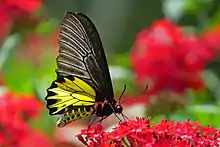Troides aeacus
Troides aeacus, the golden birdwing, is a large tropical butterfly belonging to the swallowtail family, Papilionidae.
| Golden birdwing | |
|---|---|
 | |
| Dorsal view | |
 | |
| Ventral view | |
| Scientific classification | |
| Kingdom: | |
| Phylum: | |
| Class: | |
| Order: | |
| Family: | |
| Genus: | |
| Species: | T. aeacus |
| Binomial name | |
| Troides aeacus | |
| Synonyms | |
| |
Description
- For terms see External morphology of Lepidoptera.
Troides aeacus has a wingspan reaching about 15–16 centimetres (5.9–6.3 in). In the males the forewings are black, with veins bordered by whitish colour, while the hindwings are bright yellow. The underside of the wings is quite similar to the upside. The females are larger than the males and have dark-brown or black wings. Head, thorax and abdomen of this butterfly are mainly black, with small red patches on the thorax and a yellow underside of the abdomen. Caterpillars are pale brown, with long protrusions resembling thorns. They mainly feed on Aristolochia and Thottea species (Aristolochiaceae).
Troides aeacus closely resembles Troides helena cerebrus and differs as follows:
Upperside, forewing: the pale adnervular streaks more prominent, in some specimens extended into the cell along the outer half of the subcostal and of the median nervules.
Hindwing: the cone-shaped terminal black markings in interspaces 2, 3, and 4 more or less broadly bordered on the inner side by a dusky area that is irrorated with blackish scales; the black on the costal margin narrower, not extended below vein 8.

Underside similar to the upperside, but the dusky black borders to the cone-shaped marks in interspaces 2, 3, and 4 wanting.
Antennae, head, thorax, abdomen and abdominal fold as in Troides helena cerebrus, but the abdomen beneath with two rows of black spots.
In the female the differences from cerebrus are:
Forewing: the pale adnervular streaks very broad, very prominent and extended well into the cell.
Hindwing: the basal third of the cell and of interspace 2 black, the middle portion of the latter yellow anteriorly, buffy-white posteriorly; the posterior half of the discal area between the postdiscal spots themselves and between them and the terminal cone-shaped markings more or less irrorated with blackish scales; lastly, the black in interspace 7 interrupted by an inner triangular and an outer small yellow spot.
Antennae, head, thorax and abdomen as in cerebrus, but the abdomen beneath with two lateral and two median rows of black spots.[1]
Range and status
It is found in northern India, Nepal, Burma, China, Thailand, Laos, Vietnam, Taiwan, Cambodia, peninsular Malaysia and Indonesia.
It is generally common and not threatened though it is classified as vulnerable. It is uncommon in Sumatra. May require protection in peninsular Malaya.[2]
Gallery
 Female
Female Male
Male
Subspecies
- Troides aeacus formosanus Rothschild, 1899
- Troides aeacus insularis Ney, 1905
- Troides aeacus malaiianus Fruhstorfer, 1902
- Troides aeacus szechwanus Okano & Okano, 1983
Related species
Troides aecus is the nominate member of the Troides aecus species group. The members of this clade are
- Troides aeacus C. & R. Felder, 1860
- Troides magellanus (C. & R. Felder, 1862)
- Troides minos (Cramer, [1779])
- Troides rhadamantus (Lucas, 1835)
- Troides dohertyi (Rippon, 1893)
- Troides prattorum (Joicey & Talbot, 1922)
Cited references
- Bingham, C.T. (1907). The Fauna of British India, Including Ceylon and Burma. II (1st ed.). London: Taylor and Francis, Ltd.
- Collins, N. Mark; Morris, Michael G. (1985). Threatened Swallowtail Butterflies of the World: The IUCN Red Data Book. Gland & Cambridge: IUCN. ISBN 978-2-88032-603-6 – via Biodiversity Heritage Library.
References
- Evans, W.H. (1932). The Identification of Indian Butterflies (2nd ed.). Mumbai, India: Bombay Natural History Society.
- Gay, Thomas; Kehimkar, Isaac David; Punetha, Jagdish Chandra (1992). Common Butterflies of India. Nature Guides. Bombay, India: World Wide Fund for Nature-India by Oxford University Press. ISBN 978-0195631647.
- Haribal, Meena (1992). The Butterflies of Sikkim Himalaya and Their Natural History. Gangtok, Sikkim, India: Sikkim Nature Conservation Foundation.
- Kunte, Krushnamegh (2000). Butterflies of Peninsular India. India, A Lifescape. Hyderabad, India: Universities Press. ISBN 978-8173713545.
- Kurt Rumbucher; Béla von Knötgen (1999). Part.6, Papilionidae. 3, Troides. 1 aeacus- group in Erich Bauer and Thomas Frankenbach Eds. Butterflies of the World Keltern: Goecke & Evers 1999. ISBN 978-3-931374-72-3
- Wynter-Blyth, Mark Alexander (1957). Butterflies of the Indian Region. Bombay, India: Bombay Natural History Society. ISBN 978-8170192329.
External links
| Wikimedia Commons has media related to Troides aeacus. |
| Wikispecies has information related to Troides aeacus. |